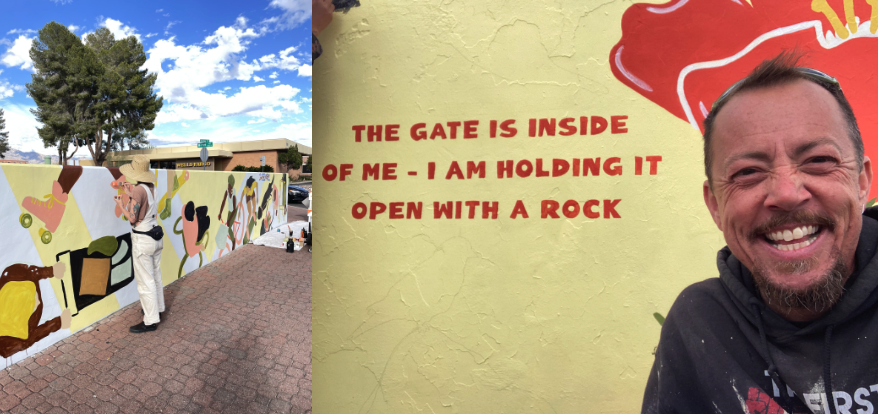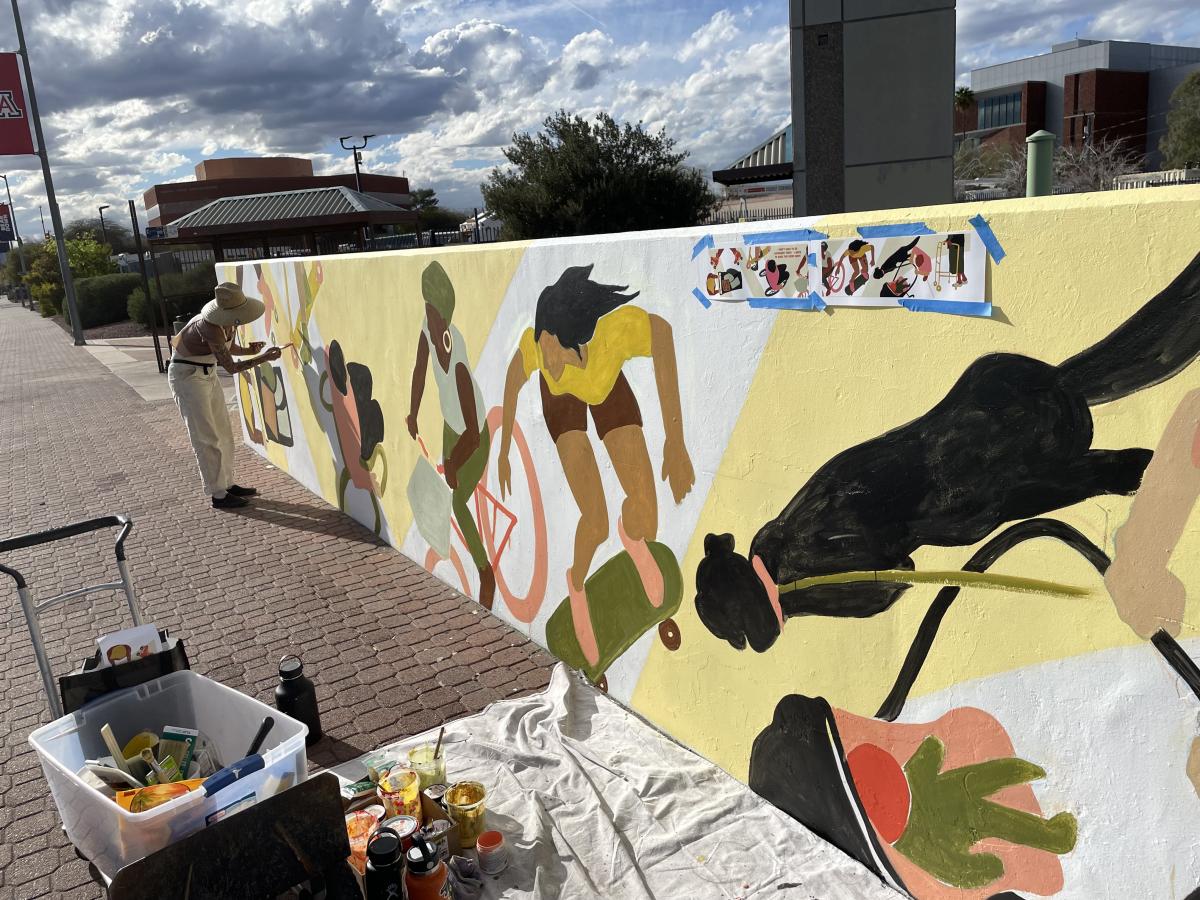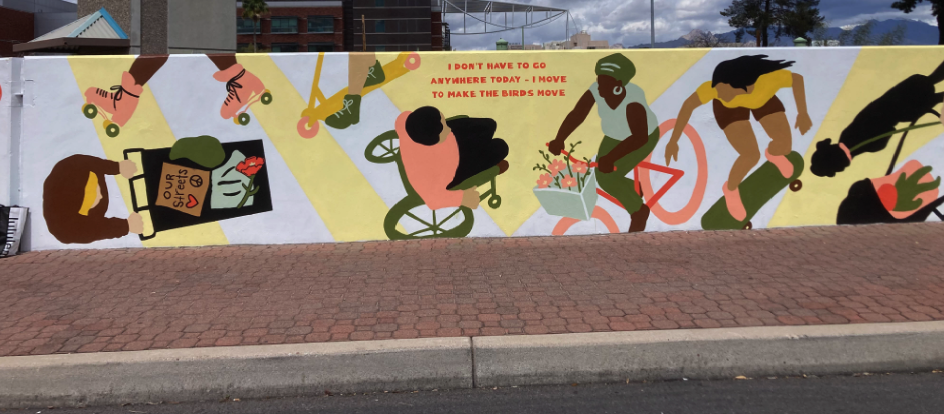In this series of interviews, Melissa Goodrich speaks to the artists who created poetry-inspired murals along the Speedway corridor. Today's interviewee is Monique Laraway.
Public art is an incredible way to bring art to the masses:
Art for the people by the people, unbound by corporate walls.
—Monique Laraway

advocating for safer spaces that are accessible and programs that grow community.
How long have you been an artist/muralist?
Since my teens, I have been drawing, painting and making weird things from salvaged materials. In hopes to be considered for the Speedway Corridor Mural Project last year, I painted my first mural at my house; I guess that’s when I became a muralist.
What led you to becoming a muralist? How would you describe your style, influences, or goals?
I love how murals encourage and empower interaction with strangers and spaces. Becoming a muralist was a logical evolution to my background in drawing and painting. Experiencing the process by helping several friends with their projects helped make it feel more attainable.
Since I’m new to making murals and adapting to working on a large scale, I chose to keep my shapes and subject matter simplified while maintaining bold bright colors and clean lines. A big inspiration for this mural is mobility justice, movement and accessibility. This commuter corridor led itself well to highlighting the diversity of movement and non-motorized forms of transportation throughout the city. Our society is so consumed by individualism and car-centricity that showing this imagery felt like an important shift in the narrative of shared public space.

Tell me about the poem that inspired your mural. How did you discover it? How did you take the words and transform them into images?
T.C. Tolbert is someone I admire as a human and writer. I’m really inspired by T.C.’s current work in building out safer spaces and skill sets in the trades for Women, Queer, Trans, and Femme of Center people through various projects (BOSS - @buildingout; The Outlaw Project - @theoutlawproject1). I love the playful way s/he writes and the vulnerability in sharing so much of his personal story. Something Tolbert says is that “s/he is a human in love with humans doing human things” and this mural is people doing just that.
The kite tattoo on the skater is a tribute to the annual Made For Flight project that T.C. started in 2010, “ a youth empowerment project that utilizes creative writing and kite building to celebrate trans lives, develop trans competency, and create a living memorial commemorating transgender people who were murdered in the previous year.”
Various birds and flowers are used throughout his poetry and I painted finches and poppies on the outer walls. It’s spring now and wildflowers are in full bloom, especially the poppies. The poppy is a national symbol of peace and perseverance of the people of Palestine and I wanted to share that symbol of solidarity as our liberation (people, plants, animals, earth) is interconnected.
it’s a vision of how the cityscape can look when everyone has access
to safer spaces and mobility. I hope the mural inspires interconnection
and a practice of envisioning safer public spaces.

Haikus from the ‘Nine Haiku’ poem:
“The gate is inside
Of me - I am holding it
Open with a rock.”
( I love how relatable and open-ended this can be. It feels hopeful. It’s facing the bus stop and I hope it becomes a space for contemplation. )
“I don’t have to go
Anywhere today - I move
To make the birds move.”
( From the onset, I wanted to incorporate birds. They are a symbol of peace, joy and freedom. I also love the visual of this as well as the possibility in metaphor. )
Tell me about the mural itself: what you included, your process, and/or how you hope people respond to your work.
I wanted to challenge the dominant narrative of gender roles while also representing the diversity of the population in movement including age, race, ability and class. Though vague and imperfect, it’s a vision of how the cityscape can look when everyone has access to safer spaces and mobility. I hope the mural inspires interconnection and a practice of envisioning safer public spaces. That’s a lot for anyone to gather from just passing by, so if nothing else, I hope it elicits contemplation and joy!
What do you think public art like murals are important?
Public art is an incredible way to bring art to the masses: Art for the people by the people, unbound by corporate walls. Generally, it’s accessible and can totally transform how people move through and interact with space. I received many honks, inquiries and words of encouragement during the painting process and I love that connective element. Public art can create pause and contemplation while moving through the soul-crushing sea of capitalism that is the cityscape. We all deserve access to free beautified spaces: parks, libraries, roadways, shelter, etc. For example, a neglected alley can be transformed into a community garden and art space. Investing money into projects that bring people together, like murals, grows community.

Why do you think poetry is important?
Poetry and writing can be so liberating. It can be open-ended and allow room for interpretation; as well as be a way to visually see, share and validate personal experience. It’s something we can control when the world around us feels so imbalanced. It can be as real or vague as desired and breaking the “rules” is celebrated. It’s a practice in liberatory imagination, unrestrained by social constructs and a powerful form of connecting people and conveying messages in protest movements.
When not mural-making, how do you spend your time? Do you have a 'day job' or do you get to make art fulltime?
Art-making has been my job for about 3 years now while also taking on other types of work to supplement income as needed. Outside of that role, I spend a lot of time learning about the identification, uses and cultivation of local plants (weeds, invasive, native) and have been incorporating that into some of my art. My partner and I have been slowly rewilding the alleyway behind our house and transforming it into a greenspace for pollinators and people. I also love biking, spending time in nature and hanging out with my 16-year-old lab Gnar.
What else would you like to share?
Thanks for the opportunity to create in partnership with the UofA Poetry Center! I’m honored to share space with you all.
____
Monique Laraway (@revolta_art) is an eco-conscious multidisciplinary visual artist in Tucson, AZ. Often working on a small scale, they create Sonoran Desert and bicycle-themed artwork using reclaimed materials. Laraway draws inspiration from navigating the city and trails by bicycle; dreaming of more sustainably interconnected resources; and learning from the symbiotic relationships of small creatures in their natural habitats. Laraway has supported several mural initiatives in the Tucson community; Alley Cat Murals is excited to facilitate Laraway’s first solo public work. Laraway is focused on creating a public piece that incorporates transportation and mobility justice.

